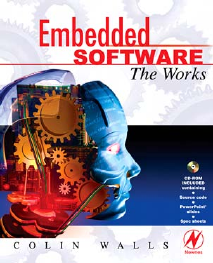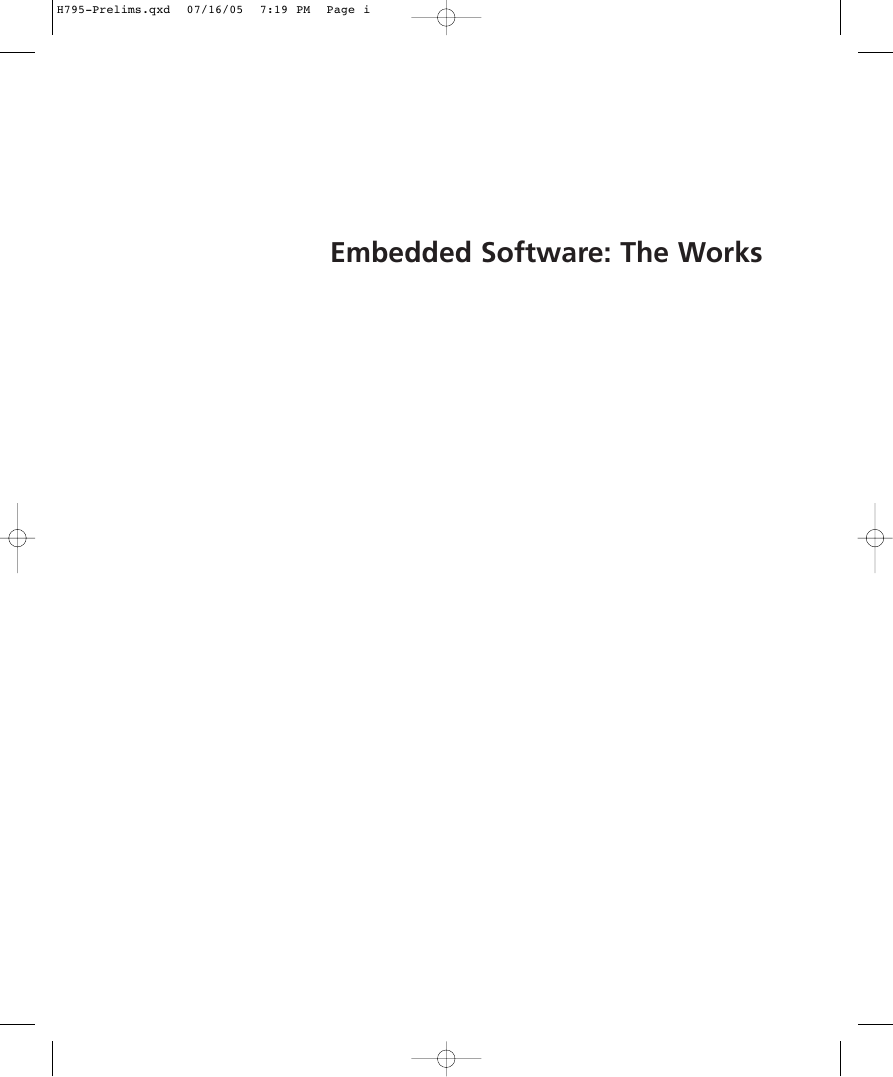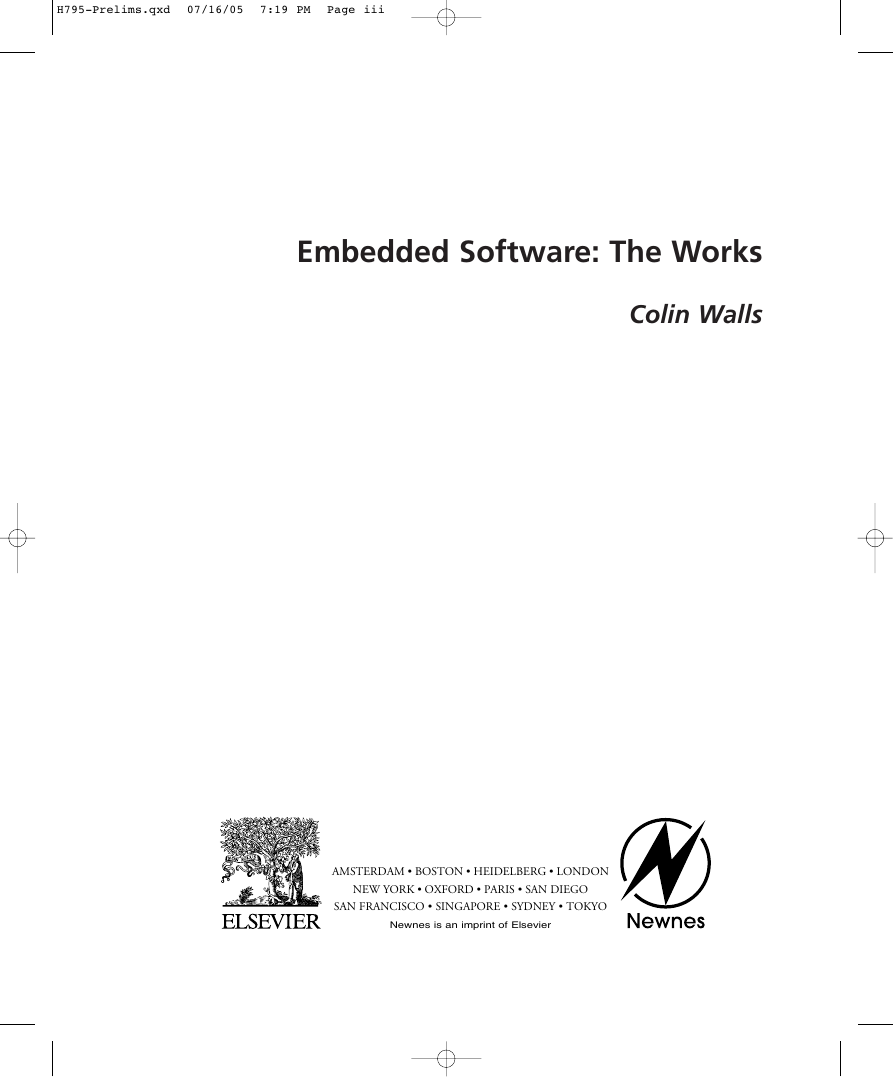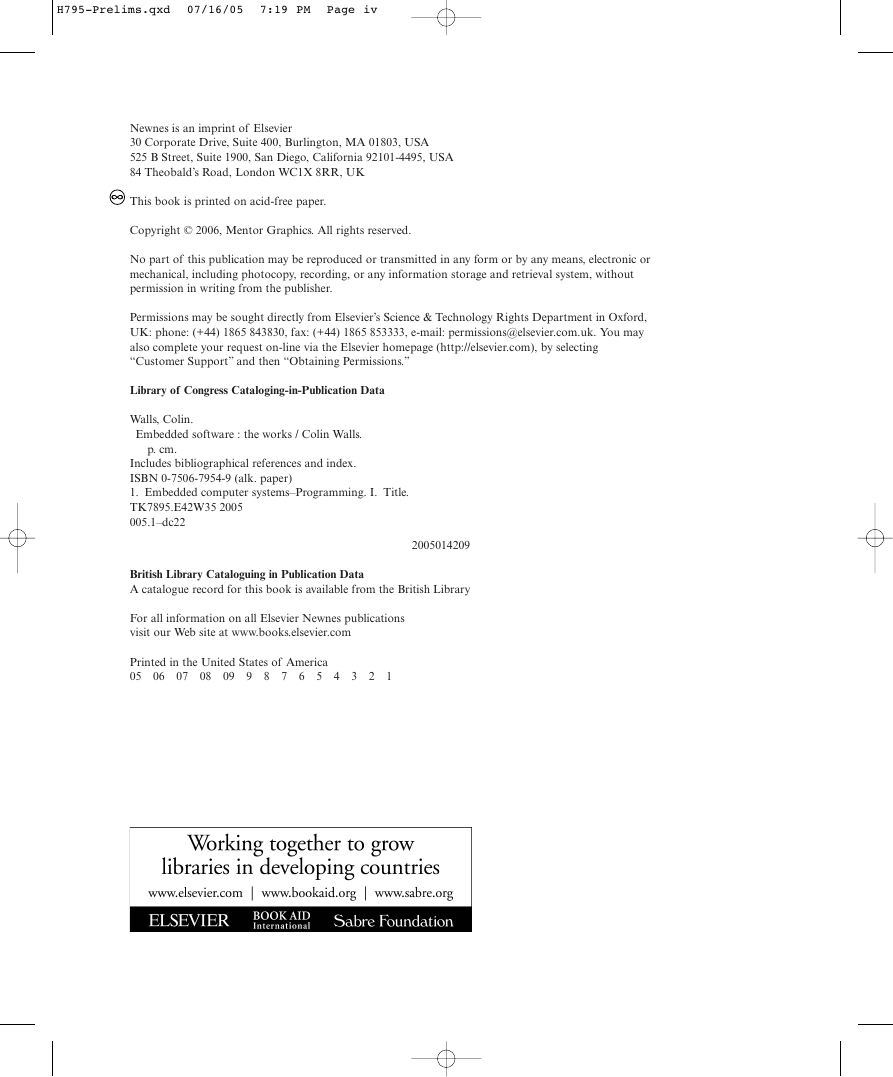front cover
copyright
Dedication
table of contents
front matter
Foreword: What Do You Expect - Perfection?
Preface
How This Book Came About
Where This Book Came From
What You Will Find Here
Who This Book Is For
How to Use This Book
Acknowledgments
Contributors
A Good Cause
Contact Me
What's on the CD-ROM?
Code Fragments
body
1 Embedded Software
1.1 What Makes an Embedded Application Tick?
1.2 Memory in Embedded Systems
1.3 Memory Architectures
1.4 How Software Influences Hardware Design
1.5 Migrating Your Software to a New Processor Architecture
1.6 Testing Computers on Wheels
1.7 Embedded Software for Transportation Applications
1.8 How to Choose a CPU for Your System on Chip Design
1.9 An Introduction to USB Software
1.10 USB On-the-Go
2 Design and Development
2.1 Emerging Technology for Embedded Systems Software Development
2.2 Making Development Tool Choices
2.3 Eclipse - Bringing Embedded Tools Together
2.4 A Development System That Crosses RTOS Boundaries
2.5 Embedded Software and UML
2.6 Model-Based Systems Development with xtUML
3 Programming
3.1 Programming for Exotic Memories
3.2 Self-Testing in Embedded Systems
3.3 A Command-Line Interpreter
3.4 Traffic Lights: An Embedded Software Application
3.5 PowerPC Assembler
4 C Language
4.1 C Common
4.2 Using C Function Prototypes
4.3 Interrupt Functions and ANSI Keywords
4.4 Optimization for RISC Architectures
4.5 Bit by Bit
4.6 Programming Floating-Point Applications
4.7 Looking at C - A Different Perspective
4.8 Reducing Function Call Overhead
4.9 Structure Layout - Become an Expert
4.10 Memory and Programming in C
4.11 Pointers and Arrays in C and C++
5 C++
5.1 C++ in Embedded Systems - A Management Perspective
5.2 Why Convert from C to C++?
5.3 Clearing the Path to C++
5.4 C++ Templates - Benefits and Pitfalls
5.5 Exception Handling in C++
5.6 Looking at Code Size and Performance with C++
5.7 Write-Only Ports in C++
5.8 Using Nonvolatile RAM with C++
6 Real Time
6.1 Real-Time Systems
6.2 Visualizing Program Models of Embedded Systems
6.3 Event Handling in Embedded Systems
6.4 Programming for Interrupts
7 Real-Time Operating Systems
7.1 Debugging Techniques with an RTOS
7.2 A Debugging Solution for a Custom Real-Time Operating System
7.3 Debugging - Stack Overflows
7.4 Bring in the Pros - When to Consider a Commercial RTOS
7.5 On the Move
7.6 Introduction to RTOS Driver Development
7.7 Scheduling Algorithms and Priority Inversion
7.8 Time versus Priority Scheduling
7.9 An Embedded File System
7.10 OSEK - An RTOS Standard
8 Networking
8.1 What's Wi-Fi?
8.2 Who Needs a Web Server?
8.3 Introduction to SNMP
8.4 IPv6 - The Next Generation Internet Protocol
8.5 The Basics of DHCP
8.6 NAT Explained
8.7 PPP - Point-to-Point Protocol
8.8 Introduction to SSL
8.9 DHCP Debugging Tips
8.10 IP Multicasting
9 Embedded Systems and Programmable Logic
9.1 FPGAs and Processor Cores: The Future of Embedded Systems?
9.2 FPGA-Based Design Delivers Customized Embedded Solutions
9.3 Xilinx MicroBlaze Soft-Core Processor
9.4 Real-Time Operating Systems for FPGA
back matter
Afterword: Great Expectations
index
















 2023年江西萍乡中考道德与法治真题及答案.doc
2023年江西萍乡中考道德与法治真题及答案.doc 2012年重庆南川中考生物真题及答案.doc
2012年重庆南川中考生物真题及答案.doc 2013年江西师范大学地理学综合及文艺理论基础考研真题.doc
2013年江西师范大学地理学综合及文艺理论基础考研真题.doc 2020年四川甘孜小升初语文真题及答案I卷.doc
2020年四川甘孜小升初语文真题及答案I卷.doc 2020年注册岩土工程师专业基础考试真题及答案.doc
2020年注册岩土工程师专业基础考试真题及答案.doc 2023-2024学年福建省厦门市九年级上学期数学月考试题及答案.doc
2023-2024学年福建省厦门市九年级上学期数学月考试题及答案.doc 2021-2022学年辽宁省沈阳市大东区九年级上学期语文期末试题及答案.doc
2021-2022学年辽宁省沈阳市大东区九年级上学期语文期末试题及答案.doc 2022-2023学年北京东城区初三第一学期物理期末试卷及答案.doc
2022-2023学年北京东城区初三第一学期物理期末试卷及答案.doc 2018上半年江西教师资格初中地理学科知识与教学能力真题及答案.doc
2018上半年江西教师资格初中地理学科知识与教学能力真题及答案.doc 2012年河北国家公务员申论考试真题及答案-省级.doc
2012年河北国家公务员申论考试真题及答案-省级.doc 2020-2021学年江苏省扬州市江都区邵樊片九年级上学期数学第一次质量检测试题及答案.doc
2020-2021学年江苏省扬州市江都区邵樊片九年级上学期数学第一次质量检测试题及答案.doc 2022下半年黑龙江教师资格证中学综合素质真题及答案.doc
2022下半年黑龙江教师资格证中学综合素质真题及答案.doc